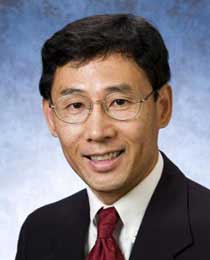
Renyi Zhang
Distinguished Professor
Primary Appointment
Atmospheric Science
Our research has covered a wide variety of topics in atmospheric chemistry, in particular, the impacts of global air pollution on human health, ecosystems, and climate:
(i) Photochemical oxidation of volatile organic compounds (VOCs) emitted from anthropogenic and biogenic sources has major implications for local and regional air quality. We conduct laboratory work to investigate the hydrocarbon oxidation reactions initiated by hydroxyl radical (OH) and other radical species, focusing on the formation of intermediate radicals and their subsequent degradation reactions. In addition, calculations using quantum chemical and kinetic rate theories are performed to study the structures, energetics, and isomeric branching to assess the preferred pathways of the organic radicals. Our objective is to quantitatively understand the kinetics and mechanism of VOC photooxidation and their roles in tropospheric ozone and secondary aerosol formation.
(ii) Aerosols in the atmosphere profoundly impact human health, radiative transfer, weather, and climate. We combine experimental and theoretical approaches to investigate nucleation, growth, and transformation of aerosols at the fundamental molecular level. These include elucidation of the formation of thermodynamically stable clusters from molecular complexes and clusters, the growth of stable clusters to nano- and submicrometer-sized particles, and transformation and properties of submicrometer-sized particles. The physicochemical properties of aerosols are measured to assess their effects on weather, human health, and climate.
(iii) Advanced experimental techniques have been developed in our group to elucidate fundamental gas-phase kinetics and aerosol chemistry. Also, we have developed state-of-the-art instruments to measure trace gases and aerosols in the atmosphere. Our instruments have been deployed to study multi-phase atmospheric chemical processes worldwide, including Houston, California-Mexico bounder, and Mexico City.
(iv) We employ chemical transport models (CTMs) to investigate formation of ozone and particulate matter as well as air quality on the urban and regional scales. We also assess aerosol-cloud-climate interactions using various cloud-resolving, mesoscale, and climate models.
(v) We utilize advanced animal models to elucidate the mechanisms underlying adverse health effects of exposure to ultrafine particles on early life development.
(vi) Our latest work focuses on understanding the interactions between climate change, air quality, and public health as well as integration between science and policy for air quality improvement and climate protection.
B.S., 1983, Atmospheric Science, Nanjing Institute of Meteorology
M.S., 1989, Physics, University of Nevada-Reno
Ph.D., 1993, Atmospheric Chemistry, Massachusetts Institute of Technology
Dr. Renyi Zhang’s scientific endeavors have advanced the understanding of four pressing global issues: (i) air pollution, (ii) climate change, (iii) stratospheric ozone layer depletion, and (iv) the COVID-19 pandemic. His team has developed state-of-the-art methodologies for atmospheric chemistry, weather, and climate research, including experimental techniques to elucidate gas-phase kinetics and aerosol chemistry, instruments to measure trace gases and aerosols in the atmosphere as well as regional and global models to represent aerosol and cloud processes and assess the aerosol-cloud-climate interactions. In the realm of air pollution, his investigations have provided critical insights into the fundamental formation mechanisms and impacts of fine aerosols or particulate matter (PM). His groundbreaking work includes first explaining the mysterious chemistry behind the historic 1952 London Fog and contemporary severe hazes in Asia, a critical contribution to air quality improvement worldwide. His research on aerosols and their radiative forcing has far-reaching implications for climate studies and has improved the assessment of black carbon (BC)'s role in global warming. His research has transformed the understanding of aerosol-cloud interactions, their effects on climate, and the global impacts of regional air pollution, all of which are essential for addressing climate change and accurate predicting weather extremes. In addition, his work has advanced the understanding of adverse health effects on early life development due to exposure to ultrafine particles. During the COVID-19 pandemic, he published two important papers that provided the first pivotal evidence on the airborne transmission of the virus and the efficacy of masking in preventing inter-human transmission, with major implications for protecting the public. His earlier research on stratospheric chemistry contributed to understanding the mechanisms behind the Antarctic ozone hole formation. He is an elected Fellow of American Association for the Advancement of Science, American Meteorological Society (AMS), and American Geophysical Union (AGU). He was honored by a named symposium at the 2016 National Meeting of the American Chemical Society and received the Humboldt Research Award in 2023.
Dr. Zhang has mentored an elite cadre of early career scientists, including 23 doctoral dissertations, 11 Master theses, 28 postdocs/research scientists, and 14 exchange graduate students. His doctoral students have broadly received employments in academia (e.g., a tenured associate professor at Purdue University, an assistant professor at Stanford University, an assistant professor at University of Connecticut, an endowed Professor at University of New Haven, an associate Lab Director at Florida International University, etc.), government (e.g., a deputy division director at DOE and research scientists at NOAA and NASA, etc.), and industry (e.g., environmental scientists at Intel Corporation, Samsung, Research Triangle International, Aerodyne Research, etc.).